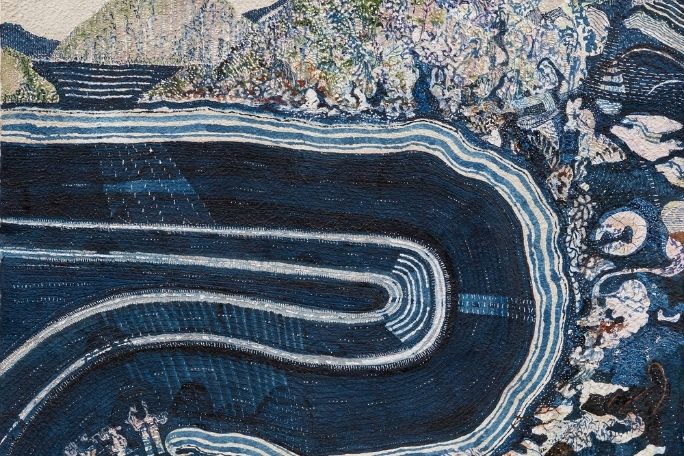Lesson summary
Have you ever wondered why sitting under that tree, on the beach or playing with your friends outside suddenly makes you feel relaxed, grounded and at ease? Maybe it is the smell of flowers or fresh air that allows us to declutter and recentre? Or maybe it is the perfect place where we can loosen up and capture beauty as it is happening.
In this art lesson, students will explore a new place and discover how nature can foster creativity and inspire students to give birth to new ways of seeing and doing. Throughout the lesson, the student will understand that travelling to a new place does not necessarily mean a foreign country. Students might consider how they could potentially travel to a new park, town, a tree they have never sat under before, on a hill, next to a river — any environment that inspires them to be creative.
While painting in nature, students are encouraged to let go of perfectionism and follow their own creative flow as they develop drawings and paintings to describe what they are seeing. However, just as nature does, they will encounter some obstacles that may change the course of their brush stroke.
Learning intentions:
Students will...
- understand why nature and the environment is an important element to art and creativity
- develop an understanding of creative intuition and how to follow their natural instincts
- understand how to enhance their intentions through exploration of how artists use materials, techniques and processes.
Success criteria:
Students can..
- follow their creative intuition and innate curiosity to develop art
- discuss the importance of letting go of perfectionism and the vitality that can come from making art in nature
- discuss and show how they have implemented new techniques and materials during their art-making.
Lesson guides and printables
Curriculum links
Select your curriculum from the options below.
Lesson details
Curriculum mapping
Australian Curriculum content descriptions:
Years 5 & 6 Visual Arts:
- Develop and apply techniques and processes when making their artworks (ACAVAM115)
Year 7 & 8 Visual Arts:
- Develop ways to enhance their intentions as artists through exploration of how artists use materials, techniques, technologies and processes (ACAVAM119)
- Practise techniques and processes to enhance the representation of ideas in their art-making (ACAVAM121)
Syllabus outcomes Stage 3: VAS3.1, VAS3.2, VAS3.3, VAS3.4
Syllabus outcomes Stage 4: 4.1, 4.2, 4.4, 4.5, 4.6
General capabilities: Literacy, Personal and Social Capabilities, Critical and Creative Thinking
Cross-curriculum priority: Sustainability
Relevant parts of Year 5 & 6 achievement standards:
By the end of Year 6, students explain how ideas are represented in artworks they make and view. They describe the influences of artworks and practices from different cultures, times and places on their art-making.
Students use visual conventions and visual arts practices to express a personal view of their artworks. They demonstrate different techniques and processes in planning and making artworks. They describe how the display of artworks enhances meaning for an audience.
Relevant parts of Year 7 & 8 achievement standards:
By the end of Year 8, students identify and analyse how other artists use visual conventions and viewpoints to communicate ideas and apply this knowledge in their art-making. They explain how an artwork is displayed to enhance its meaning. They evaluate how they and others are influenced by artworks from different cultures, times and places.
Students plan their art-making in response to the exploration of techniques and processes used in their own and others’ artworks. They demonstrate use of visual conventions, techniques and processes to communicate meaning in their artworks.
This lesson is part of the wider unit of work Lord Howe Island – Artist in residence
Time required: 85 mins – excluding washing up and placing art materials away
Level of teacher scaffolding: Medium – facilitate class discussion and prompt students to consider why mother nature and human nature play a vital role in the process of making art
Resources required
- A device capable of presenting a video to the class
- Art portfolio or large sheets of paper suitable for ink drawings or watercolour
- Paint and pencil for drawing and painting exercise
- Paintbrush
- Portfolio or booklet dedicated to the Joshua Yeldham art lessons
- Sticky tape or rope so that students can attach their stick (extension) to their paintbrush
- Student resource booklet: Joshua Yeldham Student Resource
Skills
This lesson is designed to build students’ competencies in the following skills:
- Communication
- Critical thinking
- Creativity
- Cultural understanding
- Problem solving
- Flexibility
- Social skills
Additional info
If you would like to access additional information about Joshua Yeldham and the photographs of his wonderful exhibition 'Providence'. Please visit the Arthouse Gallery website: Joshua Yeldham - Providence (arthousegallery.com.au/exhibitions/joshua_yeldham/providence) and the artist's website: Joshua Yeldham (www.joshuayeldham.com.au) for exhibitions and his wonderful book: Surrender (joshuayeldham.com.au/the-books). Providence and Surrender were completed during and after his Artist Residency on Lord Howe Island and during his stay at the Capella Lodge (capellalodge.com.au) on Lord Howe Island.


Welcome back!
Don't have an account yet?
Log in with:
Create your free Cool.org account.
Many of our resources are free, with an option to upgrade to Cool+ for premium content.
Already have an account?
Sign up with:
By signing up you accept Cool.org's Terms and Conditions(Opens in new tab) and Privacy Policy(Opens in new tab).